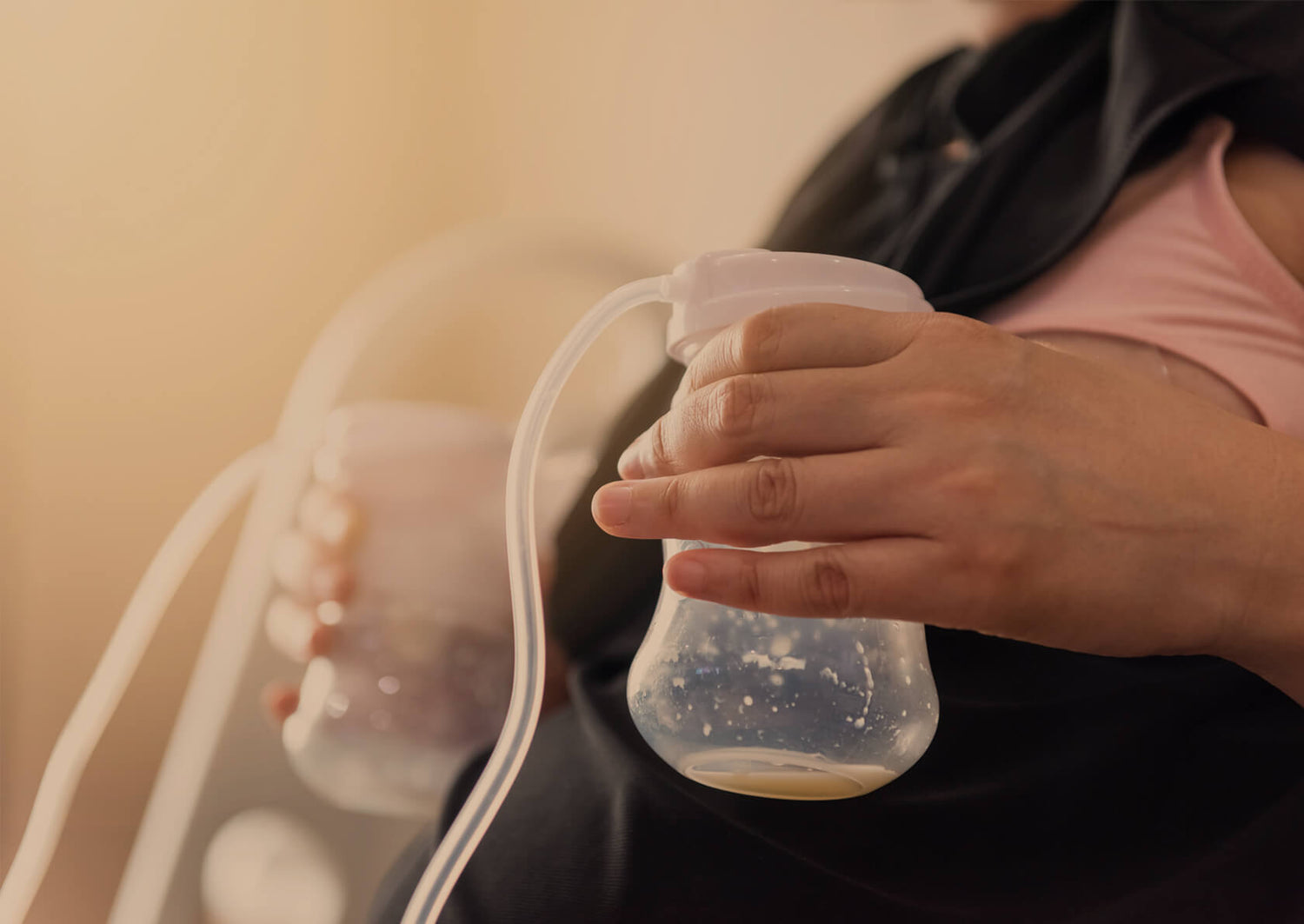Exclusive pumping, pumping, expressing – whatever you choose to call it, many breastfeeding mamas will pump their breast milk a little or a lot over the course of their breastfeeding journey. But some mamas become what’s known as an exclusive pumper – a mama who feeds their baby pumped breastmilk but doesn’t feed them directly from the breast.

We spoke to exclusive pumper and Certified Lactation Counsellor (CLC) in training, Dani Barnes, to find out more. Dani is a mama of one (with another on the way – congratulations, Dani!) and the founder of To The Pump and Back, an Instagram account supporting exclusive pumpers.
Dani explains why mamas might exclusively pump, what you need to know before you start, and how you can make your exclusive pumping journey as easy as possible.

Why exclusively pump?
There are many reasons why a mama might exclusively pump. Your baby might have a cleft palate, heart issue, low tone, tongue tie or other medical reason for not being able to feed from the breast. Some mamas start pumping while their baby is in NICU and then end up carrying on because they have difficulty establishing breastfeeding. Other mamas experience prolonged breast refusal when their baby resists feeding from the breast. Some mamas exclusively pump because they’re separated from their baby, because they’re returning to work, for example, or they may just prefer to feed their baby breastmilk from a bottle.
For Dani, a combination of factors started her on her exclusive pumping journey. “I didn’t have a supply issue, but my daughter couldn’t effectively get enough milk out to feed herself, and she also had breast refusal most of the time. If I had persisted with breastfeeding [without pumping], there was a risk my supply would have dropped below the level she needed.”
What do you need to know about exclusive pumping before you start?
Dani says the place to start your exclusive pumping journey is with the right pump. “I would recommend finding a pump with a variety of settings and a powerful motor,” she says. “Even though higher suction doesn't equal more milk, having a pump with a range of settings and a powerful motor means that whether your body responds to softer or stronger suction, your pump can do both.” Breast pump suction power is listed in mmHg. For exclusive pumpers, Dani recommends a primary pump with an mmHg greater than 300. You might need to shop online to find pumps of this strength.
While you can buy a pump during pregnancy, sizing your flanges is best done after you’ve given birth. The flange is the funnel-like part of the pump placed on the nipple, forming a vacuum seal with the areola. Because your nipple size fluctuates throughout pregnancy, measuring flange size once your baby is born is more accurate. Dani says a rough way to find out your flange size is to measure your nipple before pumping and add 1 to 2mm, but she recommends being properly sized by a lactation consultant experienced with pumping.
How do I know I’m pumping properly?
First of all, Dani says, pumping shouldn’t hurt. If it’s hurting, it means something’s not right. Keep the suction to a comfortable level. If too much areola is being pulled into the flange, the flange is the wrong size. The standard flanges that come with most pumps tend to be on the large side, she warns.
It can be helpful when pumping to see when the milk starts to flow and when it stops, Dani says, but for exclusive pumpers, she recommends timing pumping sessions rather than basing them on milk flow. This is because even if the milk isn’t actively flowing, the nipple pulling will still trigger oxytocin and other milk-producing hormones to assist with more milk production in the next session.
Dani’s top tips for exclusive pumping
- Make sure you have the right equipment. Dani recommends a powerful rechargeable pump, correctly sized flanges, and good quality hands-free pumping bra. She says a pumping set-up that gives you the option to sit and relax or multitask and do other things while you pump can make life easier. Some mamas find they can shorten their pumping sessions while still producing the same amount of milk by gently massaging their breasts with a Lactamo while they pump.
- Work out your let-down trigger. Different things trigger different mamas’ let-down reflexes, Dani says, and working out what triggers yours can help with pumping. For some mamas, it’s looking at photos of their baby to prompt that rush of milk-producing hormones. Meanwhile, Dani knew of an exclusive pumper whose let-down was triggered by the sound of her breast pump. Other mamas find their let-down comes more easily with tactile stimulation, like a gentle massage with a warm Lactamo ball. Most pumps have a let-down setting, too, which imitates the softer, quicker sucking motion of a baby at the start of a breastfeed. The pressure to produce milk can sometimes inhibit a pumper’s let-down reflex, so Dani says covering your milk bottles with socks and distracting yourself while pumping by watching TV, for example, can help take the pressure off. Massage with a Lactamo has also been reported to improve milk production while pumping.
- Make sure your breasts are draining properly. Dani says heat and vibration are great tools to promote effective breast drainage during a pumping session. Good drainage is important for exclusive pumpers to avoid clogged ducts and keep mastitis at bay. Dani explains that gentle massage with a warm Lactamo can be useful for exclusive pumpers to ensure the milk is flowing and draining effectively. Some mamas report that the Lactamo helps aid drainage when breasts are hard and engorged too. Keep an eye out for the fatty hindmilk at the end of a pumping session – it can be a sign that your pump is draining your breast sufficiently. Dani notes however that although it’s useful to look out for the fatty hindmilk at the end of the session, the nutritional difference between hindmilk and foremilk is mostly a myth: unless you have a diagnosed foremilk imbalance (which is quite rare) all of your breastmilk is incredible and nothing to get stressed about.
- Wait to use breast pump collection cups or wearable pumps. These are types of pumps that sit inside your bra. Dani says that while some mamas respond to them well, others don’t, and their milk supply can lower as a result. For that reason, she recommends waiting until your supply is properly established, around 12 weeks after your baby is born, before you try these types of pumps.
- Surround yourself with support. Unfortunately, there is a stigma and lack of awareness about exclusive pumping, and exclusive pumpers sometimes experience judgement and criticism, Dani says. Whether you’re exclusively pumping out of choice or necessity, it is a valid feeding choice. Having pumping-friendly support around you – whether it’s a supportive lactation consultant who understands pumping, an online community or friends who have been or are currently undergoing a similar journey – can make all the difference.
If in doubt, please always consult your healthcare professional.






